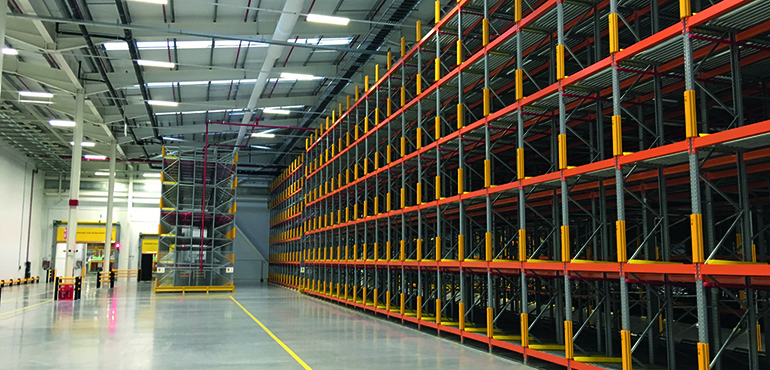Good warehouse racking protection saves lives and increases efficiency. Here’s everything you need to know to get the right protection for your racking.
- Identify risks
- Find the solutions
- Review the suppliers
- Evaluate the costs
- Install racking protection

1. Identifying the risks
First, conduct a thorough risk assessment of your racking shelves to identify vulnerable areas and potential impact hotspots. This will tell you exactly what needs protecting and why.
A risk assessment will:
- Highlight hazards
- Identify any vulnerable areas
- Assess the likelihood of an incident occurring
The HSE encourages regular rack inspections to monitor damage or deterioration. Regular inspections highlight where changes are needed, and identify specific protection requirements.
Get the official HSE warehouse risk assessment form here.
2. Finding the solutions
Once you have identified the hazards around your racking, you can evaluate the data to find the best solutions.
Previous risk assessments and accident reports will help to identify any further risks, and tell you how frequently incidents arise.
Some issues may be solved by changes to processes or procedures, such as implementing one-way traffic systems. However, the data may show areas which require a physical form of protection, such as:
- Rack leg protectors, to protect rack legs from workplace vehicles
- Rack end barriers, to protect the end of your aisles.
- Kerb barriers, to protect against vehicle forks, and any damage or injury at ground level.
- Racking monitoring systems, to detect and monitor rack impacts.
Find out more about the different types of warehouse racking protection.

3. Review suppliers
Choosing a reputable supplier is vital. The manufacture, design, and performance of industrial safety products can be the difference between life and death.
Many workplace safety barrier suppliers make bold claims about the performance of their products, but how do you know which safety barriers carry an impact rating you can trust? Can you afford to wait until there is a workplace incident to find out if your barriers are fit for purpose?
It is always important to research whether suppliers have had their products tested and approved by accredited sources, such as TÜV Nord. This ensures the products have been tested to replicate real-life impacts, so you can feel confident that they will provide the necessary level of protection when you need it.
Suppliers should be able to provide the certificates, as well as video evidence of product performance when impacted at speed and under proper test conditions.
Product reviews, legitimate customer testimonials, and video case studies will give insight into supplier trust. They also give you more information about the installation process and what to expect.
4. Evaluate costs
The initial cost of racking protection will vary, depending on the supplier you have chosen and the quality of the material used.
Advanced polymer protection may cost more than steel alternatives or cheap polymer alternatives, but will usually need replacing far less frequently due to its ability to take several impacts and reform to its original shape. It is also self-coloured, and UV stabilised, so will not require any repainting.
Suppliers should be happy to break down the costs and explain the Return on Investment of their products. This will help you to evaluate which protection is the most suitable for your budget.
Find out more about the benefits of polymer vs steel.
5. Installing racking protection
It is important your supplier conducts a site survey, as the structure of your facility will impact which protection they recommend. For example, rack leg protectors may have a ‘snap-on’ feature that allows them to grip to the racking, or they will require bolting to the rack posts. Rack end barriers will need to be bolted to the floor.
Any racking protection must be installed correctly, as a poorly installed safety system could fail in preventing impacts. Most safety manufacturers will supply detailed instructions for installing their products, and they may also provide the relevant installation tools.
Some suppliers will have their own installation teams who will fit the products for you. This is the recommended approach to take, as their team will have in-depth knowledge of the products and will ensure they are installed quickly and efficiently.
Summary
Before buying any racking protection, it is important to always
- Conduct a risk assessment.
- Identify the main risks to your racking.
- Use the data to establish what protection is needed.
- Research the suppliers and their testing standards.
- Read reviews, case studies and testimonials.
- Evaluate the costs, and take into account the Return on Investment.
At A-SAFE, we can help you to identify the risks at your warehouse with our free site surveys, and our dedicated installation team are always on hand to ensure your products are fitted correctly. Call our sales team on (443) 776-3472 or email us at [email protected] and find out what we can do for you.

